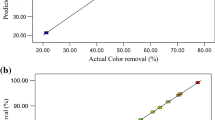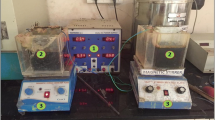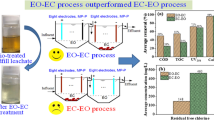Abstract
Landfill leachate is one of the most obstinate wastewaters to be treated due to its toxic organic and inorganic pollutants. The landfill leachate must be treated prior to discharge into a watercourse in order to preserve human health and ecosystem. Pre-characterization of raw landfill leachate was done to identify the concentration of certain pollutants, in which the effluent concentration of chemical oxygen demand, ammoniacal nitrogen, and color was 1990 mg/L, 300 mg/L, and 1946 Pt–Co, respectively. The present study was conducted to treat raw landfill leachate using the electroflotation system with a designed titanium and coated titanium DSA electrodes. The experiments were conducted following the central composite design of experiments, and the design was analyzed using response surface methodology (RSM). The influence of current density, initial pH, and contact time was evaluated on the removal of COD, NH3–N, and color by ANOVA. It was found that current density and pH were the most effective parameters on COD and NH3–N removal; nevertheless, the color obtained the highest removal was up to 80%. The optimal experimental conditions were determined to be current density of 28 (A/m2), initial pH 6.0, and processing time of 30 min. Under these experimental conditions, the maximum removal of COD, color, and NH3–H was 75%, 63%, and 83%, respectively. The findings of the present study reveal that the electroflotation technique could be utilized to treat landfill leachate as an effective pre-treatment process.







Similar content being viewed by others
References
Abd Manaf L, Samah MAA, Zukki NIM (2009) Municipal solid waste management in Malaysia: practices and challenges. Waste Manage 29(11):2902–2906
Alam R, Shang JQ (2017) Removal of bitumen from mature oil sands tailings slurries by electro-flotation. J Water Process Eng 15:116–123
Amor C, De Torres-Socías E, Peres JA, Maldonado MI, Oller I, Malato S, Lucas MS (2015) Mature landfill leachate treatment by coagulation/flocculation combined with Fenton and solar photo-Fenton processes. J Hazard Mater 286:261–268
Amr SA, Aziz HA, Hossain MS, Bashir MJ (2017) Simultaneous removal of COD and color from municipal landfill leachate using Ozone/Zinc sulphate oxidation process. Glob Nest J 19(19):498–504
Anju G, Subha B, Muthukumar M, Sangeetha T (2019) Application of response surface methodology for sago wastewater treatment by Ozonation. Iran J Energy Environ 10(2):96–103
Antonyováa ANNA, Antonyb PETER (2018) Electro-flotation as the method of the water treatment in recycling process of contaminated water as an integral part of the reverse logistics system. J Southwest Jiaotong Univ 53(5)
Aoudj S, Khelifa A, Drouiche N, Hecini M (2016) Removal of fluoride and turbidity from semiconductor industry wastewater by combined coagulation and electroflotation. Desal Water Treat 57(39):18398–18405
Asaithambi P, Beyene D, Aziz ARA, Alemayehu E (2018) Removal of pollutants with determination of power consumption from landfill leachate wastewater using an electrocoagulation process: optimization using response surface methodology (RSM). Appl Water Sci 8(2):69
Atashzaban Z, Seidmohammadi A, Nematollahi D, Azarian G, Heidary SO, Rahmani AR (2016) The efficiency of electrocoagulation and electroflotation processes for removal of polyvinyl acetate from synthetic effluent. Avicenna J Environ Health Eng 3(2):7469–7469
Azmi NB, Bashir MJ, Sethupathi S, Wei LJ, Aun NC (2015) Stabilized landfill leachate treatment by sugarcane bagasse derived activated carbon for removal of color, COD and NH3–N–optimization of preparation conditions by RSM. J Environ Chem Eng 3(2):1287–1294
Behera SK, Meena H, Chakraborty S, Meikap BC (2018) Application of response surface methodology (RSM) for optimization of leaching parameters for ash reduction from low-grade coal. Int J Mining Sci Technol 28(4):621–629
Brienza M, Katsoyiannis IA (2017) Sulfate radical technologies as tertiary treatment for the removal of emerging contaminants from wastewater. Sustainability 9(9):1604
Chen H, Sun Y, Ruan X, Yu Y, Zhu M, Zhang J, Qian G (2016) Advanced treatment of stabilized landfill leachate after biochemical process with hydrocalumite chloride (Ca/Al–Cl LDH). Bioresource Technol 210:131–137
Darvishmotevalli M, Zarei A, Moradnia M, Noorisepehr M, Mohammadi H (2019) Optimization of saline wastewater treatment using electrochemical oxidation process: Prediction by RSM method. MethodsX 6:1101–1113
Dimoglo A, Sevim-Elibol P, Dinç Ö, Gökmen K, Erdoğan H (2019) Electrocoagulation/electroflotation as a combined process for the laundry wastewater purification and reuse. J Water Process Eng 31:100877
Ekawati D, Nadira R (2018) Application of response surface methodology (RSM) for wastewater of hospital by using electrocoagulation. IOP Conf Ser Mater Sci Eng 345(1):012011
Erabee IK, Ahsan A, Jose B, Aziz MMA, Ng AWM, Idrus S, Daud NNN (2018) Adsorptive treatment of landfill leachate using activated carbon modified with three different methods. KSCE J Civil Eng 22(4):1083–1095
Estrada-Vázquez C, Salinas-Pacheco A, Peralta-Reyes E, Poggi-Varaldo HM, Regalado-Méndez A (2019) Parametric optimization of domestic wastewater treatment in an activated sludge sequencing batch reactor using response surface methodology. J Environ Sci Health Part A 54(12):1197–1205
Fernandes A, Pacheco MJ, Ciríaco L, Lopes A (2015) Review on the electrochemical processes for the treatment of sanitary landfill leachates: present and future. Appl Catalysis B: Environ 176:183–200
Gautam P, Kumar S, Lokhandwala S (2019) Advanced oxidation processes for treatment of leachate from hazardous waste landfill: a critical review. J Cleaner Prod p 117639
Ghafari S, Aziz HA, Isa MH, Zinatizadeh AA (2009) Application of response surface methodology (RSM) to optimize coagulation–flocculation treatment of leachate using poly-aluminum chloride (PAC) and alum. J Hazard Mater 163(2–3):650–656
Hassani G, Alinejad A, Sadat A, Esmaeili A, Ziaei M, Bazrafshan AA, Sadat T (2016) Optimization of landfill leachate treatment process by electrocoagulation, electroflotation and sedimentation sequential method. Int J Electrochem Sci 11:6705–6718
Johari A, Alkali H, Hashim H, Ahmed SI, Mat R (2014) Municipal solid waste management and potential revenue from recycling in Malaysia. Modern Appl Sci 8(4):37
Jiménez C, Sáez C, Cañizares P, Rodrigo MA (2016) Optimization of a combined electrocoagulation-electroflotation reactor. Environ Sci Pollut Res 23(10):9700–9711
Kamaruddin MA, Abdullah MMA, Yusoff MS, Alrozi R, Neculai O (2017) Coagulation-flocculation process in landfill leachate treatment: focus on coagulants and coagulants aid. IOP Conf Ser Mater Sci Eng 209(1):012083
Khalek A, El-Hosiny FI, Selim KA, Osama I (2017) Produced Water Treatment Using a New Designed Electroflotation Cell. Int J Res Industrial Eng 6(4):328–338
Kjeldsen P, Barlaz MA, Rooker AP, Baun A, Ledin A, Christensen TH (2002) Present and long-term composition of MSW landfill leachate: a review. Crit Rev Environ Sci Technol 32(4):297–336
Kulikowska D, Zielińska M, Konopka K (2019) Treatment of stabilized landfill leachate in an integrated adsorption–fine-ultrafiltration system. Int J Environ Sci Technol 16(1):423–430
Li R, Wang B, Owete O, Dertien J, Lin C, Ahmad H, Chen G (2017) Landfill leachate treatment by electrocoagulation and fiber filtration. Water Environ Res 89(11):2015–2020
Li YL, Wang J, Yue ZB, Tao W, Yang HB, Zhou YF, Chen TH (2017) Simultaneous chemical oxygen demand removal, methane production and heavy metal precipitation in the biological treatment of landfill leachate using acid mine drainage as sulfate resource. J Biosci Bioeng 124(1):71–75
Mahalik K, Sahu JN, Patwardhan AV, Meikap BC (2010) Statistical modelling and optimization of hydrolysis of urea to generate ammonia for flue gas conditioning. J Hazard Mater 182(1–3):603–610
Mirhosseini H, Tan CP, Taherian AR, Boo HC (2009) Modeling the physicochemical properties of orange beverage emulsion as function of main emulsion components using response surface methodology. Carbohyd Polym 75(3):512–520
Mohtashami R, Shang JQ (2019a) Electroflotation for Treatment of Industrial Wastewaters: A Focused Review. Environ Proc 6(2):325–353
Mohtashami R, Shang JQ (2019b) Treatment of automotive paint wastewater in continuous-flow electroflotation reactor. J Cleaner Prod 218:335–346
Mohtashami R, Shang JQ, Xu Y (2018) Treatment of automotive paint wastewater using electroflotation: kinetic study, influencing factors and data analysis. Environ Proc 5(3):577–591
Mostefa NM, Tir M (2004) Coupling flocculation with electroflotation for waste oil/water emulsion treatment. Optim Oper Cond Desalin 161(2):115–121
Muhamad MH, Abdullah SRS, Mohamad AB, Rahman RA, Kadhum AAH (2013) Application of response surface methodology (RSM) for optimisation of COD, NH3–N and 2, 4-DCP removal from recycled paper wastewater in a pilot-scale granular activated carbon sequencing batch biofilm reactor (GAC-SBBR). J Environ Manag 121:179–190
Mukherjee S, Mukhopadhyay S, Hashim MA, Sen Gupta B (2015) Contemporary environmental issues of landfill leachate: assessment and remedies. Crit Rev Environ Sci Technol 45(5):472–590
Naje AS, Ajeel MA, Alaba PA, Chelliapan S (2018) Treatment of textile wastewater using a novel electrocoagulation reactor design. Wastewater Water Qual pp 111–123
Naje AS, Ajeel MA, Ali IM, Al-Zubaidi HA, Alaba PA (2019) Raw landfill leachate treatment using an electrocoagulation process with a novel rotating electrode reactor. Water Sci Technol 80(3):458–465
Nizaa NM, Emmanuela MI, Shadia AMH, Yusofc MSM, Kamaruddina MA (2019) Role of turbulent flow and gas bubbles in enhancing mass transfer in batch electrocoagulation: a brief review. Desal Water Treat 161:35–47
Ntambwe Kambuyi T, Eddaqaq F, Driouich A, Bejjany B, Lekhlif B, Mellouk H, Dani A (2019) Using response surface methodology (RSM) for optimizing turbidity removal by electrocoagulation/electro-flotation in an internal loop airlift reactor. Water Supply 19(8):2476–2484
Pereira CP, da Conceição Pereira T, Gomes G, Quintaes BR, Bila DM, Campos JC (2018) Evaluation of reduction estrogenic activity in the combined treatment of landfill leachate and sanitary sewage. Waste Manag 80:339–348
Robinson T (2017) Removal of toxic metals during biological treatment of landfill leachates. Waste Manag 63:299–309
Taqwa A, Syakdani A (2017) Treatment of landfill leachate by electrocoagulation using aluminum electrodes. In: MATEC web of conferences (Vol 101, p 02010). EDP Sciences
Wang C, Alpatova A, McPhedran KN, El-Din MG (2015) Coagulation/flocculation process with polyaluminum chloride for the remediation of oil sands process-affected water: performance and mechanism study. J Environ Manag 160:254–262
Xu Q, Siracusa G, Di Gregorio S, Yuan Q (2018) COD removal from biologically stabilized landfill leachate using advanced oxidation processes (AOPs). Process Saf Environ Prot 120:278–285
Acknowledgments
The author would like to thank the management of Pulau Burung Sanitary Landfill (PBSL) for providing easy access to all the facilities. Many thanks go to the Technology and Industry School at University Sains Malaysia for providing the laboratories and equipment for this research. The authors wish to thank all who assisted in conducting this work.
Author information
Authors and Affiliations
Corresponding author
Additional information
Editorial responsibility: Samareh Mirkia.
Rights and permissions
About this article
Cite this article
Shadi, A.M.H., Kamaruddin, M.A., Niza, N.M. et al. Electroflotation treatment of stabilized landfill leachate using titanium-based electrode. Int. J. Environ. Sci. Technol. 18, 2425–2440 (2021). https://doi.org/10.1007/s13762-020-03005-3
Received:
Revised:
Accepted:
Published:
Issue Date:
DOI: https://doi.org/10.1007/s13762-020-03005-3




